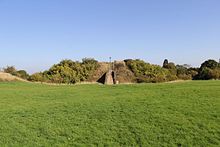Pleshey Castle
Pleshey Castle is an abandoned castle in the village of Pleshey , northwest of Chelmsford in the English county of Essex .
country
Geoffrey de Mandeville received Pleshey from King William the Conqueror as a reward for his services. He was one of Wilhelm's commanders at the Battle of Hastings in 1066. De Mandeville made Pleshey his caput (headquarters of the manor). Later his grandson, another Geoffrey de Mandeville, was appointed Earl of Essex by King Stephen .
Castle
Originally the castle was a moth consisting of a wooden palisade and a tower on a mound , which was surrounded by a core and an outer bailey. The two courtyards were protected by a moat early on . Later, probably in the 12th century, the mound was fortified with a stone castle. Today the mound is one of the largest in England at around 15 meters high.
The castle was demolished in 1158 and rebuilt towards the end of the 12th century. She fell by marriage to the Dukes of Gloucester . After Thomas de Woodstock, 1st Duke of Gloucester , was executed at the behest of King Richard II in 1397, Pleshey Castle fell into ruin . Most of the masonry was demolished in 1629 to obtain building material for other buildings. Only the mound and the other earthworks remained.
Historical meaning
For a long time, Pleshey Castle was an important place in English history. Henry de Bohun, 1st Earl of Hereford , and his wife Maud , sister and heir to William de Mandeville , the Earl of Essex, lived in the castle. De Bohun's son Humphrey became Earl of Essex, Earl of Hereford and hereditary constable of England on August 27, 1236. Generations of the De Bohuns resided in Pleshey, which they made their caput . Humphrey de Bohun, 4th Earl of Hereford and 3rd Earl of Essex (approx. 1275-1322), married Elizabeth , the daughter of King Edward I , on November 14, 1302. Some of the couple's children were born in Pleshey. The 4th Earl of Hereford fell at the Battle of Boroughbridge in 1322 after rebelling against King Edward II.
In 1327, Pleshey Castle became the main residence of Humphrey de Bohun's eldest surviving son, John de Bohum, 5th Earl of Hereford and 4th Earl of Essex. He died in 1336 without descendants and the castle fell to his brother, Humprhey de Bohun, 6th Earl of Hereford and 5th Earl of Essex († 1361). The youngest of the brothers, William de Bohun († 1360) became the leading commander in the first part of the Hundred Years War , developed the tactics that led to victory for England in the Battle of Morlaix (1342), the Battle of Crécy (1346) and the siege of Calais (1347) and was appointed Earl of Northampton .
The 6th Earl of Hereford never married and Pleshey Castle fell in 1361 to William de Bohun's son Humphrey de Bohun, 7th Earl of Hereford , 6th Earl of Essex and 2nd Earl of Northampton, the last direct male heirs of the family. His only heirs after his death on January 13, 1373 were two underage daughters, Eleanor and Mary . The second cousin of the 7th Earl of Hereford, Gilbert de Bohun († 1381), was passed over and the castle and the titles were passed to the husbands of the two daughters through a legal ruse.
From 1361 to 1364, a group of created Augustinians the manuscripts of the De Bohuns on Pleshey Castle, 11 books, one of them a Psalter in which Mary de Bohuns marriage to Henry Bolingbroke , later King Henry IV. Of England, was celebrated. Mary, who died before her husband became king, was the mother of what would later become King Henry V.
The castle then fell through the marriage of Eleanor to Thomas de Woodstock, the younger son of King Edward III. , to these. His nephew Richard II , offended by his uncle's opposition, had him locked up at Pleshey Castle and taken to France .
Two years later the Duke of Exeter was moved to Pleshey Castle and executed for treason against the king.
Pleshey Castle also plays a role in William Shakespeare's play Richard II .
swell
- MM Bigelow: The Bohun Wills . Volume I. American Historical Review (vI, 1896). Pp. 415-441 and (v.II, 1897). Pp. 631-649.
- G. Cokayne, V. Gibbs (Editor): Complete Peerage of England, Scotland, Ireland, Great Britain and the United Kingdom . London 1887-1896. Volumes II, V, VI, IX: Bohun, Essex, Hereford, & Northampton .
- Dictionary of National Biography . Volume II: Bohun . London and Westminster.
Web links
Coordinates: 51 ° 48 ′ 18 ″ N , 0 ° 24 ′ 39.6 ″ E
